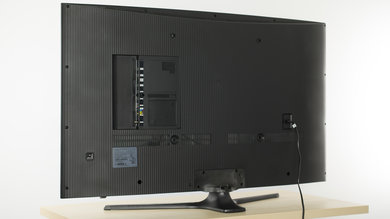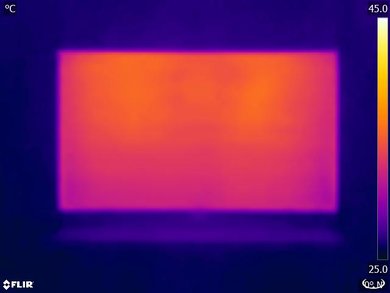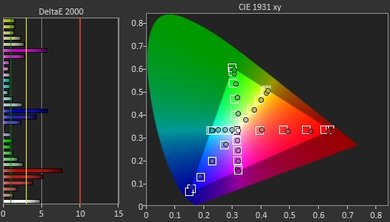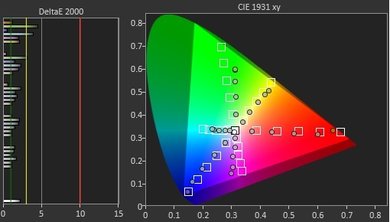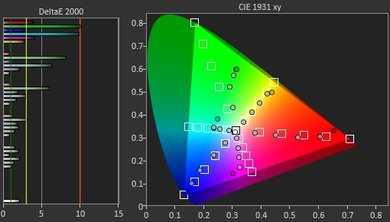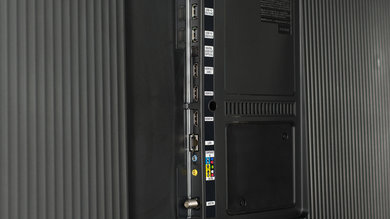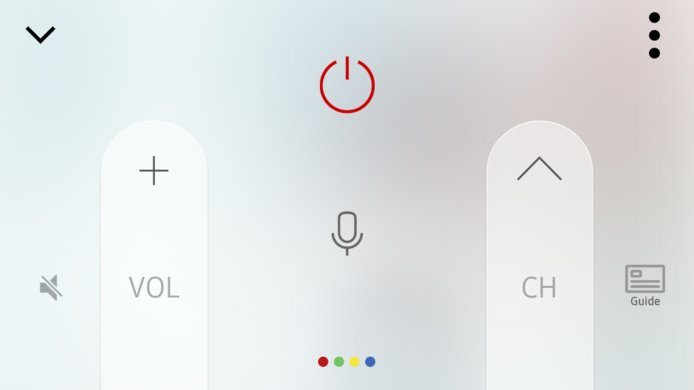Our Verdict
Decent TV for a mixed usage. The MU6500 doesn't excel at anything, but it provides a good experience for most usages. Its picture quality is good, but it might have issues if placed in a bright living room with wide seating arrangements because of its limited viewing angle and brightness.
- Low input lag
- High contrast and uniform blacks
- Picture quality deteriorates at an angle
- Could be a bit brighter
Passable TV for movies in a dark room. The MU6500's contrast and black uniformity are good, but it lacks a local dimming feature to enhance them even further. It also cannot playback 24p content without minor judder, but not everybody is sensitive to this problem.
The MU6500 does a decent job with TV shows, it has a decent soap opera effect, and it's smart platform makes it easy to access content from apps like Netflix and Amazon Prime video. Unfortunately, though, it could be a bit brighter, and its handling of reflections isn't the best.
Decent TV for watching sports. The MU6500's screen uniformity is good, so fields and ice rinks look even and free of blotches. Its viewing angle is quite narrow though, so it's not a great choice for viewing parties where people are going to be sitting to the side of the TV.
Great TV for video games, the MU6500 has a low input lag making inputs responsive. Its handling of motion is also decent, so fast moving objects show limited trailing.
Average TV for HDR movies. While the MU6500 does support HDR10, it lacks a wide color gamut and doesn't get very bright. Because of this, HDR movies will show a limited effect.
The MU6500 maintains its gaming performance well with HDR games since its input lag isn't affected.
Passable PC monitor. While decent for normal use, the MU6500's motion blur might be a bit high for PC use. moving text and mouse interaction will show a longer than usual trail which can be distracting.
Changelog
- Updated Mar 12, 2018: Converted to Test Bench 1.2.
- Updated Aug 10, 2017: Converted to Test Bench 1.1.
- Updated Jul 24, 2017: Review published.
- Updated Jul 22, 2017: Our testers have started testing this product.
Check Price
Differences Between Sizes And Variants
We tested the 55" (UN55MU6500), version FA01. For the most part, we expect our review to be valid for the other sizes.
If someone comes across a different type of panel or if their Samsung MU6500 doesn't correspond to our review, let us know and we will update the review.
| Size | Model | Warehouse Model |
| 49" | UN49MU6500 | UN49MU650DFXZA |
| 55" | UN55MU6500 | UN55MU650DFXZA |
| 65" | UN65MU6500 | UN65MU650DFXZA |
Black Friday models
For Black Friday, some retailers use alternative forms of the product name. For example, Walmart has the 65" variant on sale with product codes 65MU6500 and UN65MU6500FXZA.
There is also the 55 inch MU6490 (55MU6490, UN55MU6490, UN55MU6490FXZA) which can be found at B&H and a few other retailers. We expect this variant to share the performance of the variant we've reviewed, with the only difference being the lack of Bluetooth connectivity and the basic remote which lacks voice control (Same remote as the Samsung MU6100).
Popular TV Comparisons

The MU6500 is a decent entry-level 4k TV, and its curved design makes it a rare breed. It's tough to justify its price though, as competing models often offer a lot more value for money.
The Samsung MU6300 is a slightly better TV than the Samsung MU6500. The Samsung MU6500 is marginally better for use as a PC monitor mainly due to its curved profile. Also, the Samsung MU6300 has slightly better black uniformity which helps to improve picture quality when you are watching HDR movies. On the other hand, the Samsung MU6300 has marginally better reflection handling that becomes more apparent when watching TV shows in a brighter room.
The Samsung MU7000 and the Samsung MU6500 have very similar performance. The Samsung MU6500 is marginally better for use as a PC monitor due to its curved profile and its marginally better inputs. The Samsung MU6500 also has slightly better black uniformity that becomes apparent when you watch HDR movies. If you play HDR games, the Samsung MU6500 has slightly better input lag on 4k @ 60Hz + hdr signal. On the other hand, the Samsung MU7000 has better contrast that helps blacks in a dark room when watching HDR movies.
The Samsung MU8500 is a better TV than the Samsung MU6500. The Samsung MU8500 is better for watching movies as it has local dimming to improve blacks, much better motion handling with excellent 24p judder removal and excellent motion interpolation. The Samsung MU8500 also has marginally better SDR peak brightness so you can comfortably watch your favorite TV shows in a brighter room. Finally, the Samsung MU8500 has a slightly better color volume which is important if you play HDR games. On the contrary, the Samsung MU6500 has slightly better black uniformity that can be observed when watching HDR movies.
The Samsung NU7100 is a slightly better TV than the Samsung MU6500. The Samsung NU7100 has better input lag for video games, and a marginally better input lag when sent 4k @ 60Hz + HDR signal for HDR gaming. The Samsung NU7100 also has a slightly better black uniformity which becomes apparent in a dark room when you watch HDR movies. On the contrary, the Samsung MU6500 is slightly better for use as a PC monitor due to its curved profile and has a marginally better response time which is great for video games.

We buy and test dozens of TVs yearly, taking an objective, data-driven approach to deliver results you can trust. Our testing process is complex, with hundreds of individual tests that take over a week to complete. Most of our tests are done with specially designed test patterns that mimic real content, but we also use the same sources you have at home to ensure our results match the real-world experience. We use two main tools for our testing: a Colorimetry Research CR-100 colorimeter and a CR-250 spectroradiometer.
Test Results
The MU6500 looks good with a similar design to other 6 series Samsung TVs such as the MU6300 and KU6300 except for the additional curve. It has the iconic Samsung central stand which provides good support and can fit on most tables, but otherwise doesn't really stand out. The borders are an average thickness, and the inputs are easy to access if placed close to a wall.
The central V shaped stand supports the TV well but will wobble a bit if knocked. It looks very similar to the KU6500 from 2016.
Footprint of the 55" TV stand: 12.2" x 32.9"
The rear of the TV is made of corrugated plastic, similar to the KU6500 from 2016. It looks fine, and the inputs are easy to access from the side. Note that if attaching a VESA mount, the included spacers may be necessary, which can cause the TV to stick out a bit from the wall.
Great native contrast ratio for the MU6500. With over 5000:1, this Samsung TV can do deep blacks, which in turn makes for great dark scene performance when set in a dark home theater room. This is a very similar result as the Samsung MU6300, which is the flat counterpart.
There is no local dimming on the MU6500. The video is for reference only.
Good SDR peak brightness. The TV's CE dimming dims very dark scenes, as shown by our 2% white window test, but otherwise the brightness remains very consistent. This brightness is nearly identical to the MU6300, but less than the rival TCL P607.
Mediocre HDR peak brightness. The brightness is fairly consistent, but the TV's lack of local dimming prevents it from making highlights very bright in dark scenes. Worse, its CE dimming actually dims highlights in very dark scenes, as shown by our 2% white window test. Overall the brightness is very similar to the MU6300, but less than the rival TCL P607.
The MU6500 has a decent overall gray uniformity. For a direct-lit TV, which are often more prone to have a worse gray uniformity, the MU6500 fair well. The center of the screen is fairly even and dirty screen effect is not really a problem. Most of the gray uniformity issues come from the sides and corners being a bit darker than the center.
Not much problem can be noticed when looking at the 5% gray uniformity test picture too, which is excellent news.
Bad viewing angle, but fairly typical for a VA TV. Blacks turn grey when the TV is viewed from even a small angle, while colors shift and brightness decreases at moderate angles. This TV isn't well suited for a room where people often view the TV from the side.
Great black uniformity on the MU6500. Looking at our test picture, some faint clouding can be noticed, but it is not enough to affect the whole evenness of the screen overall and this marginal clouding is not apparent when looking at some movie clips with dark scenes.
Out of the box, the MU6500 is pretty accurate and for most people, it could be use 'as is' without any need for calibration.
The white balance is a bit on the warm side, but only toward high IRE. Looking at the gamma curve, we can see that it does not follow hoe 2.2 target closely, and this may be because Samsung TV follow a different target, but overall, the difference is not that of a problem here.
The Color dE is not too high overall, and most colors are tracking, from not too far there targets. The higher value in the red, blue and magenta are a bit more problematic than the rest though, but not enough to cause a problem while watching normal video content.
As with other Samsung TV, the calibration process was done very fast and without too many issues. Overall, the 2 and 10 points were pretty accurate and responsive for the most part, leaving only a small issues in the lower IRE, which could not be corrected completely. But when compared to the pre-calibration, this is still a very good result. As you can see, the gamma curve looks much flatter than before and is now tracking our 2.2 target very closely.
As for the color dE, it was brought down to 1.68, which is great, but the problem in the higher value in the red, blue and magenta were still present and could not be corrected completely without causing more issues than needed. In the end, even with those little problems in the higher red, blue and magenta value, it did not cause any problem while watching normal TV content.
You can see our recommended settings for this Samsung TV here.
Standard color gamut, only good enough for SDR content. Green and red fall well short of their HDR targets, especially green. Though, on the bright side, the TV is fairly accurate at showing the colors it's able to, as with many Samsung TVs.
The TV's EOTF in the 'Movie' picture mode follows the HDR PQ curve fairly well until 40% stimulus grey, where it starts to roll off severely before arriving at its max brightness. When the TV's 'Gamma' setting is made +3 this roll off is far less severe, but the darker shades are made a bit too dark, shown here. The game mode EOTF is fairly similar to Movie mode, and 'Gamma' +3 has a similar effect, shown here. PC mode's EOTF most closely follows the PQ curve, especially with 'Gamma' +3, shown here. Users should adjust the 'Gamma' setting to suit the brightness of their room.
The MU6500 does a great job displaying our gradient test image. No 8-bit banding can be seen and overall, besides some little issues in the dark green and blue, this TV does a similar job to the rest of the Samsung line of TVs.
Like the flat MU6300, the MU6500 does not suffer from any image retention.
We don't expect VA panels to experience permanent image retention, as the VA panel in our long-term test appears immune.
The MU6500 uses PWM at 120Hz to dim the backlight, starting at 12/20 backlight setting. Lowering the setting from 12/20 shortens the duty cycle, while amplitude remains constant. Backlight that uses PWM results in duplications following moving objects while helping to clear up motion slightly.
It is possible to reduce the flicker frequency to 60 Hz by setting 'Auto Motion Plus' to 'Custom' and activating 'LED Clear Motion'. If you don't mind the visible flicker produced by this option, it helps to clear up fast moving content.
The MU6500 has a 60 Hz panel which can interpolate lower frame rate content. To add the soap opera effect, set 'Auto Motion Plus' to 'Custom' and increase the 'Judder Reduction' slider. Note that any motion interpolation will introduce artifacts, so use a small value unless you really like the soap opera effect.
This TV is great at showing content without stutter. Even for low frame rate content such as 24p movies with a long frame time there is only ~22ms of static image each frame, which makes the image appear smooth even for slow panning shots.
This TV can't remove judder from 24p movies, and this independently from any type of sources, that be 24p, 60p and 60i. This is the same result as seen on the MU6300, MU7600 and even the 2016 KU6300. For most people, this is not really an issue though, as judder in movies is not often noticed, but if it is the case, a 120Hz TV like the MU8000 may be a better choice for you.
Like other 2017 TVs, the MU6500 doesn't support a variable refresh rate.
Excellent low input lag, which should please all but the most competitive gamers. Game mode and PC mode both have the same low input lag, though only PC mode can properly show 4:4:4 color. This input lag is very similar to all 2017 Samsung TVs, though not quite as good as the TCL P607.
Most resolutions are supported. 4k @ 60 Hz @ 4:2:2 or 4:4:4 color is only supported when 'HDMI UHD color' is enabled for the input used. 4:4:4 color is only displayed properly when the input's icon is set to PC (aka 'PC mode'). PC mode doesn't work for some refresh rates, such as 24 Hz. The icon will still change to PC, but the settings that are usually disabled in PC mode are not, and 4:4:4 color is not shown properly.
Only one of Dolby Digital or DTS can be enabled at a time, the TV will not switch between them automatically depending on which the content supports.
Passable frequency response. The MU6500 lacks a room correction feature that would help reduce the impacts of room modes which can cause an overemphasis in the lower frequencies.
Decent distortion performance. THD levels are acceptable, and the MU6500 is free of aliasing.
The TV did not show ads during our testing, but the appearance of ads is often inconsistent. The TV can be assumed to have ads because all Samsung TVs since 2015 have had ads, and many 2017 Samsung TVs like the MU7000 showed ads during testing. If anyone notices ads on their MU6500 please email us a picture of the ad, we'll update the review.
The TV comes pre-installed with many popular apps such as Netflix, YouTube and Amazon Video. Many more apps can be downloaded from the Apps menu. Apps run smoothly with little lag or frame drops.
The remote has few buttons but some great smart features. Its lack of buttons such as 'inputs' and 'settings' mean a trip through the Smart Hub is needed to change most things. Fortunately, its great voice command feature often allows skipping the Smart Hub entirely, by allowing commands like 'HDMI 1' or 'The Avengers' to directly change between inputs and apps, search for content, and change settings. The remote can also act as a universal remote for other devices, even if they don't support HDMI CEC, using Samsung's OneRemote feature.



